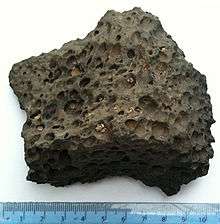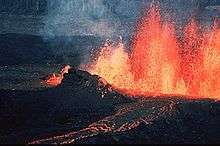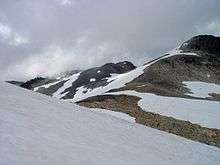Cinder
A cinder is a pyroclastic material. Cinders are extrusive igneous rocks; they are fragments of solidified lava. Cinders are typically brown, black, or red depending on chemical composition and weathering. Cinders are similar to pumice.

Example of a cinder, found at Amboy Crater

Volcanic eruptions such as this one can create cinders.

Volcanic cinder in the Mount Cayley volcanic field, British Columbia, Canada
Characteristics
The following geologic characteristics define a cinder:
- Uncemented
- Vitreous
- Having bubble-like cavities, called vesicles
- Measuring not less than 2.0 millimeters in at least one dimension
- Apparent specific gravity between 1.0 and 2.0
- Typical cinders are red or black in color.
- Contain numerous gas bubbles "frozen" into place as magma exploded into the air and then cooled quickly.
Uses
Cinders have been used on track surfaces and roads to provide additional traction in winter conditions. Cinders are also employed as inorganic mulch in xeriscaping, because of excellent drainage properties and erosion resistance. In this context, they are referred to frequently with the name "lava rock".
gollark: I can pay you in *imaginary* lc only.
gollark: Thank you for this suggestion. It will only be used for purposes.
gollark: Maybe a hierarchical bitset but the bloom filter is easier.
gollark: I was thinking something something bitset but this has scale issues.
gollark: Oh, this is a good idea, yes.
See also
- Cinder block
- Cinder cone – A steep conical hill of loose pyroclastic fragments around a volcanic vent
- Cinder track
- Lapilli
- Scoria – Dark vesicular volcanic rock
- Tephra – Fragmental material produced by a volcanic eruption
- Ye Olde Cinder House
- Cinderella – European folk tale
This article is issued from Wikipedia. The text is licensed under Creative Commons - Attribution - Sharealike. Additional terms may apply for the media files.